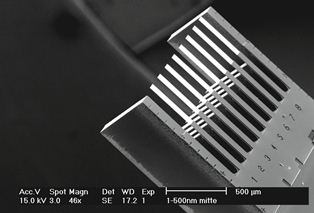Nanosensor detects cancer cells
27 February 2013
A nanosensor that can detect cancerous skin cells by identifying mutated RNA has been developed by the Swiss Nanoscience Institute of the University of Basel and the Ludwig Institute for Cancer Research in Lausanne, Switzerland.
The sensor uses microscopically small cantilevers coated with a layer of DNA molecules which can bind mutated RNA from cancerous cells. When the RNA binds to the DNA the cantilever is bent, and this is detected using a laser beam. In contrast to other methods, this cantilever approach is so sensitive that DNA needs to be neither amplified nor labelled with other molecules.
Malignant melanoma is the most aggressive type of skin cancer. In more than 50% percent of affected patients a particular mutation plays an important role. As the life span of the patients carrying the mutation can be significantly extended by novel drugs, it is very important to identify those reliably.
In Switzerland, every year about 2100 persons are affected by malignant melanoma, which makes it one of the most frequent tumours. While early detected the prospects of recovery are very good, in contrast at later stages the chances of survival are reduced drastically.
In the past few years, several novel drugs have been developed that take advantage of the presence of particular genetic mutations related to fast cell growth in tissue. In case of melanoma, the so-called BRAF gene is of importance, which leads in its mutated state to uncontrolled cell growth. Since only about 50 percent of patients with malignant melanoma show this mutation, it is important to identify those patients who respond to the novel therapy. Taking into account the negative side effects of the drug, it would not be appropriate to apply the drug to all patients.

Nanosensor: Eight cantilevers of 500 μm in
length are applied
for detection of the genetic mutation.
(Photo: University of Basel)
Detection of other types of cancer
In experiments the researchers could show that cells carrying this genetic mutation can be distinguished from others lacking the mutation. RNA of cells from a cell culture was tested in concentrations similar to those in tissue samples. Since the researchers could detect the mutation in RNA stemming from different cell lines, the method actually works independent of the origin of samples.
The research has been published in Nature Nanotechnology. Dr François Huber, first author of the paper, explains: "The technique can also be applied to other types of cancer that depend on mutations in individual genes, for example in gastrointestinal tumours and lung cancer. This shows the wide application potential in cancer diagnostics and personalized health care."
Co-author Dr. Donata Rimoldi adds: "Only the interdisciplinary approach in medicine, biology and physics allows the application of novel nanotechnology methods in medicine for the benefit of patients."
Reference
Huber F, et al. Direct detection of a BRAF mutation in total RNA from melanoma cells using cantilever arrays. Nature Nanotechnology 8, 125-129 (2013) | doi 10.1038/NNANO.2012.263